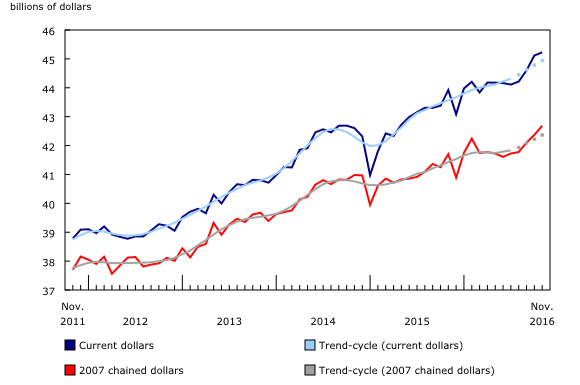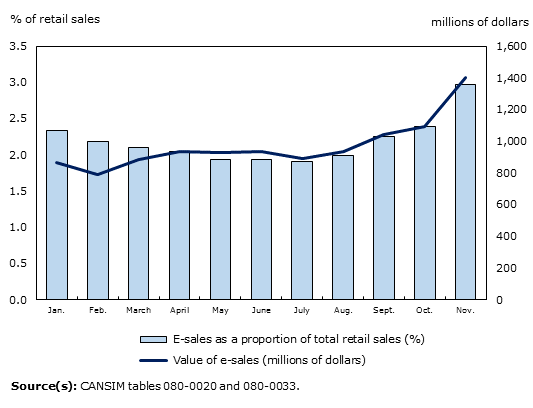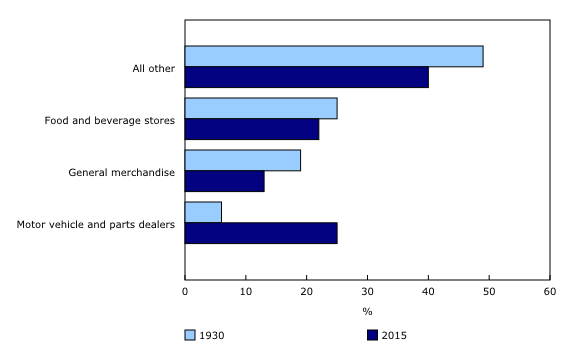Retail trade, November 2016
Archived Content
Information identified as archived is provided for reference, research or recordkeeping purposes. It is not subject to the Government of Canada Web Standards and has not been altered or updated since it was archived. Please "contact us" to request a format other than those available.
Released: 2017-01-20
$45.2 billion
November 2016
0.2% 
(monthly change)
$0.7 billion
November 2016
-0.4% 
(monthly change)
$0.2 billion
November 2016
2.1% 
(monthly change)
$1.2 billion
November 2016
2.0% 
(monthly change)
$1.0 billion
November 2016
0.8% 
(monthly change)
$9.6 billion
November 2016
0.3% 
(monthly change)
$16.5 billion
November 2016
0.5% 
(monthly change)
$1.6 billion
November 2016
0.8% 
(monthly change)
$1.6 billion
November 2016
1.6% 
(monthly change)
$6.2 billion
November 2016
-0.5% 
(monthly change)
$6.4 billion
November 2016
-0.7% 
(monthly change)
Retail sales rose for the fourth consecutive month, edging up 0.2% to $45.2 billion in November. Higher sales at motor vehicle and parts dealers and building material and garden equipment and supplies dealers were the main contributors to the gain.
Sales were up in 5 of 11 subsectors, representing 45% of total retail trade.
After removing the effects of price changes, retail sales in volume terms increased 0.7%.
Higher sales at motor vehicle and parts dealers
Sales were up for the third consecutive month at motor vehicle and parts dealers (+0.8%) in November. Higher sales at new car dealers (+1.9%) accounted for most of the gain at the subsector level. Sales at other motor vehicles dealers, which include retailers of recreational vehicles, motorcycles and boats, were up 1.8%. Lower sales were reported at automotive parts, accessories and tire stores (-11.0%) and used car dealers (-3.5%).
Store types traditionally associated with housing purchases and home renovation experienced sales growth in November. Sales at building material and garden equipment and supplies dealers (+2.9%) and furniture and home furnishings stores (+2.0%) increased for the third consecutive month. This was the largest gain in the building material and garden equipment and supplies dealers subsector since January 2016.
Following a 4.2% increase in October, receipts at gasoline stations were down 1.0% in November, reflecting lower prices at the pump.
Sales at food and beverage stores declined 0.5% in November. Lower sales at supermarkets and other grocery stores (-0.9%) more than offset higher sales at beer, wine and liquor stores (+1.4%).
Sales up in seven provinces
Retail sales were up in seven provinces in November.
Ontario (+0.5%) reported the largest increase in dollar terms, as gains were observed in 8 of 11 subsectors.
Retail sales rose for the fourth consecutive month in Quebec (+0.3%). November's gain was mainly attributable to higher sales at building material and garden equipment and supplies dealers and new car dealers.
In Saskatchewan (+1.6%), retail sales reached their highest level since June 2016, primarily on the strength of higher sales at new car dealers.
In Nova Scotia (+2.0%), retail sales increased for the fifth consecutive month in November.
Retail sales were also up in New Brunswick (+0.8%) and Prince Edward Island (+2.1%).
Following five consecutive monthly increases, sales in British Columbia fell 0.7% in November. Despite this decline, total retail sales remain above September's level.
Following three consecutive monthly gains, retail sales in Alberta were down 0.5% in November, largely due to lower sales at automotive, parts accessories and tire stores.
E-commerce sales by Canadian retailers
The figures in this section are based on unadjusted (that is, not seasonally adjusted) estimates.
On an unadjusted basis, retail e-commerce sales reached $1.4 billion in November, accounting for 3.0% of total retail sales in Canada, their highest proportion of total retail sales in 2016.
This unadjusted movement in Internet-based sales coincided with the timing of promotional events such as Black Friday.
Mixed results at stores traditionally associated with Black Friday
Store types associated with Black Friday promotions reported mixed results in November, as receipts at electronics and appliance stores were up 1.0%, while sales at sporting goods, hobby, book and music stores were down 0.3%, the first decline in three months.
Within the clothing and clothing and accessories stores subsector, gains at clothing stores (+0.1%) and jewellery, luggage and leather goods stores (+0.2%) were more than offset by lower sales at shoe stores (-1.9%).
The evolution of retail trade in Canada
As 2017 marks the 150th anniversary of Confederation, we take a look at an aspect of the history of retail trade in Canada.
Net sales of the retail automotive group amounted to $34.7 million in 1930, representing 6% of total retail trade. In 2015, 85 years later, sales in the equivalent motor vehicle parts dealers subsector totalled $126.4 billion, accounting for 25% of total retail sales.
Summary tables of unadjusted data by industry and by province and territory are now available.
For information on related indicators, refer to Latest statistics.
Note to readers
All data in this release are seasonally adjusted and expressed in current dollars, unless otherwise noted. For information on seasonal adjustment, see Seasonally adjusted data – Frequently asked questions.
Statistics Canada's retail e-commerce figures are disseminated in unadjusted form. As a result, one must use caution when comparing retail sales that are seasonally adjusted [CANSIM 080-0020] in the Daily with retail e-commerce figures [CANSIM 080-0033].
Statistics Canada's retail e-commerce figures include the electronic sales of two distinct types of retailers. The first is retailers that do not have a storefront. These businesses are commonly referred to as 'pure-play' Internet retailers and are classified to North American Industry Classification System (NAICS) 45411—Electronic Shopping and Mail Order Houses. The second type of retailer is those that have a storefront and are commonly referred to as 'brick and mortar' retailers. If the online operations of a brick and mortar retailer are separately managed, they too are classified to NAICS 45411.
CANSIM 080-0033 represents the Internet sales of Canadian based retailers. The foreign e-commerce purchases from Canadian based retailers are included in the Internet sales totals. Conversely, Internet purchases by Canadians from foreign-based retailers are not included in Statistics Canada's retail trade figures.
Common electronic commerce transactions, such as travel and accommodation bookings, ticket purchases and financial transactions are not included in Canadian retail sales figures. For more information on individual Internet use and e-commerce, consult the most recent release of the Canadian Internet Use Survey and/or the Survey of Digital Technology and Internet Use.
For more information on retail e-commerce in Canada, see Retail E-Commerce in Canada.
Total retail sales expressed in volume are calculated by deflating current dollar values using consumer price indexes. The retail sales series in chained (2007) dollars is a chained Fisher volume index with 2007 as the reference year. For more information, see Calculation of Volume of Retail Trade Sales.
For information on trend-cycle data, see the StatCan Blog and Trend-cycle estimates – Frequently asked questions.
Real-time CANSIM tables
Real-time CANSIM tables 080-8020 and 080-8024 will be updated on January 30. For more information, consult the document Real-time CANSIM tables.
Next release
Data on retail trade for December 2016 will be released on February 22, 2017.
Contact information
For more information, contact us (toll-free 1-800-263-1136; 514-283-8300; STATCAN.infostats-infostats.STATCAN@canada.ca).
For analytical information, or to enquire about the concepts, methods or data quality of this release, contact Jason Aston (613-951-0746; jason.aston@canada.ca), Retail and Service Industries Division.
- Date modified:




